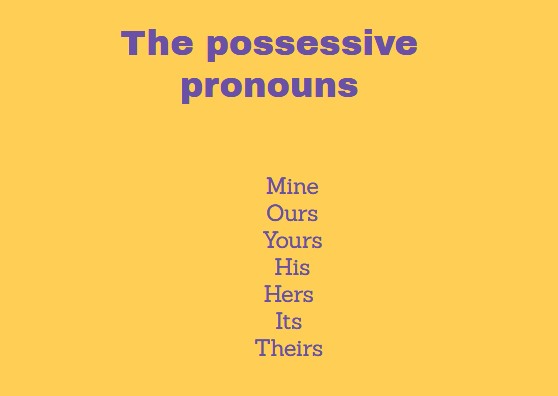The possessive pronouns are: Mine, Ours, Yours, His, Hers, Its, Theirs.
1. What is a pronoun?
A pronoun is a word used instead of a noun.
A noun is a name.
For example, if we say “John cooked lunch.”
John is a noun because it is the name of the person in the sentence.
If we said “John cooked lunch and then John cleaned the kitchen” it would sound a bit strange Because we are using the word ‘John’ twice in a sentence. To stop this repetition we can say,
“John cooked lunch and then he cleaned the kitchen”.
The word “he” means we do not use ‘John’ for a second time in one sentence.
‘He’ is a pronoun, a word which is used to replace a noun.
There are different types of pronouns but words like “I, We, You, He, She, It, They” are called “subject pronouns”
They are called “subject” pronouns because they refer to the “subject” of the sentence, that is the person or thing that does the action.
For example, we can say “Kate wrote the book” and Kate is the subject, the person who did the action. We can replace the noun Kate with the subject pronoun, ‘she‘.
2. Possessive pronouns.
The possessive pronouns are used to show that something belongs to someone. For example, we can say “This pen is John’s and the book is also John’s”, but again we would be using the name John twice and it would sound a bit strange or just unnecessary. So often we just say “This pen is John’s and the book is also his.”
His in this sentence is a possessive pronoun. Possessive pronouns usually come at the end of a sentence e.g.
- This car is mine.
- The table is ours.
- This paper is yours.
- The computer is his.
- Those shoes are hers.
- Those books are theirs.
Though we do not usually use “its” as a possessive pronouns there are some rare examples e.g.
“It was difficult to ride the horse, it had a mind of its own!“
3. The difference between possessive adjectives and possessive pronouns.
An adjective is a word used to describe something. For example, we can say “That’s an expensive watch”. The watch is a ‘noun’ name of an object and the word ‘expensive’ describes the watch.
Here are some more examples:
- That’s a beautiful flower.
- That’s a big room.
- That’s a difficult question.
“Flower”, “room”, “question” are all the names of something. Flower and room are names of something physical which we can see, but ‘question’ is also the name of a thing, we cannot touch it physically but it is a thing and exists although it exists mentally such as the words ‘happiness’, love’ which are also nouns. Such nouns which describe a thing we cannot touch or see but exists is called an ‘abstract noun‘.
The possessive adjectives are:
My, Our, Your, His, Her, Its, Their.
They go before a noun, not after.
So we say “This is my book” or “This is her book”. However possessive pronouns go after the noun.
“This watch is mine” or “This watch is hers.”
So these are the subject pronouns, possessive adjectives and possessive pronouns in one table:
4. Possessive pronouns for emphasis.
We sometimes use possessive pronouns for emphasis. For example, if someone doesn’t believe you, you can use a possessive pronoun. Here is an example:
Person A: That is my cup.
Person B: Are you sure, I thought it was Michael’s.
Person A: No, it’s mine!







